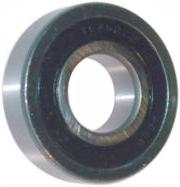Bearings
A bearing is a component used to reduce friction in a machine. Bearings may be classified broadly according to the motions they allow and according to their principle of operation. There are at least six common bearing types: sliding bearings, usually called "bushings", "journal bearings", or "plain bearings"; rolling-element bearings such as ball and roller bearings; jewel bearings, in which the load is carried by rolling the axle slightly off-center; fluid bearings, in which the load is carried by a gas or liquid; magnetic bearings, in which the load is carried by a magnetic field; and flexure bearings, in which the motion is provided by a load element which bends.
(This page contains affiliate links for which we may be compensated.)
Bearings by Brand
Universal Bearings
AC Delco
AGCO White
Allis Chalmers
Arctic Cat
Ariens
AYP
Azusa
Bad Boy
Baja Motor Sports
Billy Goat
Black & Decker
Bluebird
Bobcat
Bolens
Bombardier
Bosch
Brave
Briggs and Stratton
Bunton
Bobcat
Campbell Hausfeld
Can-Am
Case
Castle Garden
Caterpillar
Clark
Classen
Club Car
Columbia
Comet
Country Clipper
Craftsman
Cub Cadet
Cushman
Dixie Chopper
Dixon
Dolmar
DR Power
Earthquake
ECHO
Encore
Everride
Evinrude
Exmark
EZ-Go
Ferris
Ford
Frigidaire
GE
Generac
Gilson
Grasshopper
Gravely
Great Dane
Greenfield
Hayter
Hoffco
Homelite
Honda
Huskee
Husqvarna
Hustler
Hy-Capacity
Hydro Gear
ICS
Ingersoll Rand
Jacobsen
JLG
John Deere
Johnson
Jonsered
JRCO
K & S Trim-All
Kawasaki
Kees
King-O-Lawn
Kohler
Kubota
Lastec
Lawn-Boy
Lesco
LG
Makita
Manco
Mariner
Martin Wheel
Massey Ferguson
Maxim
McCulloch
Mclane
Mercury
Mopar
Mosmatic
Motorcraft
MTD
Murray
New Holland
Noma
Northstar
Nortrac
Oliver
Onan
Oregon
Peerless Transmission
Polaris
Porter Cable
Poulan
Power King
Powerhorse
PowerMate Formerly Coleman
Raisman
Red Max
Robin Subaru
Ryan
Ryobi
Scag
Sears Craftsman
Simplicity
SKF
Ski-Doo
Skyjack
Snapper
Steiner
Stiga
Stihl
Suzuki
Swisher
Taylor-Dunn
Tecumseh
Toro
Trail Mate
Troy Bilt
Velke
Vermeer
Viking
Wacker
Walker
Weed Eater
Wheel Horse
Whirlpool
White Outdoors
Wisconsin
Woods
Worldlawn
Wright MFG
Yamaha
Yanmar
Yard Machines
Yardman
Yazoo Kees
Common motions include linear and rotary. A linear bearing allows motion along a straight line, for example a drawer being pulled out and pushed in. A rotary bearing allows motion about a center, such as a wheel on a shaft or a shaft through a housing. Common kinds of rotary motion include both one-direction rotation and oscillation where the motion only goes through part of a revolution.
History
An early type of linear bearing was an arrangement of tree trunks laid down under sleds. This technology is known to date at least as far back as the construction of the Pyramids of Giza. Modern linear bearings use a similar principle, sometimes with balls in place of rollers.
The first plain and rolling-element bearings were wood, but ceramic or glass can be used, and steel, other metals, and plastic are all common today.
Rotary bearings are required for many applications, from heavy-duty use in vehicle axles and machine shafts, to precision clock parts. The simplest rotary bearing is the sleeve bearing, which is just a cylinder inserted between the wheel and its axle. This was followed by the roller bearing, in which the sleeve was replaced by a number of cylindrical rollers. Each roller behaves as an individual wheel. The first practical caged-roller bearing was invented by horologist John Harrison in his H3 chronometer of 1760.
An early example of a wooden ball bearing (see rolling-element bearing), supporting a rotating table, was retrieved from the remains of a Roman ship in Lake Nemi, Italy. The wreck was dated to 40 BC. Leonardo da Vinci is said to have described a type of ball bearing around the year 1500. One of the issues with ball bearings is that they can rub against each other, causing additional friction, but this can be prevented by enclosing the balls in a cage. The captured, or caged, ball bearing was originally described by Galileo in the 1600s. The mounting of bearings into a set was not accomplished for many years after that. The first patent for a ball race was by Philip Vaughan of Carmarthen in 1794. The modern, self-aligning design of ball bearing is attributed to Sven Wingquist of the SKF ball-bearing manufacturer in 1907.
Source and additional information: https://en.wikipedia.org/wiki/Bearing_(mechanical)
